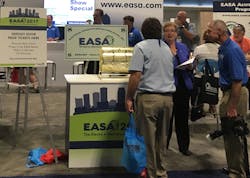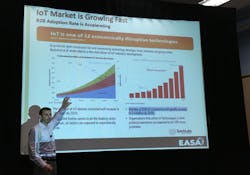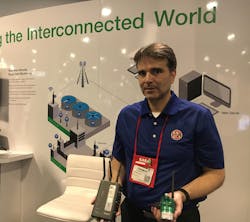The Electrical Apparatus Service Association hosted its annual convention this week (June 25 – 27) in Tampa, Florida. Themed "Partners for Progress," the event was attended by EASA members, end users, manufacturers and service providers who engaged wholeheartedly in a full schedule of educational presentations, exhibits and networking sessions.
During my time at the event, I found the discussions to be lively, and there was an air of positivity in the exhibit hall. As I sit back and reflect on the educational sessions I sat in on and my discussions with attendees and exhibitors at EASA 2017, I’ve come up with five key takeaways from the show.
1. While there may be a variety of ways to describe the Industrial Internet of Things (IIoT), there’s a common theme.
The number of B2B IoT connections is expected to increase to 5.4 billion by 2020.
Chris Wiseman of Nidec Motor Company presented a session at EASA 2017 titled "The Industrial Internet of Things: What Does It Mean to You?," during which he presented the range of definitions of IIoT being bandied about today. And while there is no standard definition for IIoT, most revolve around a common theme of using a network of sensors to gather intelligence, analyze it and develop benchmarks and action plans for making decisions. Some of the IIoT process chains Wiseman covered during his presentation included:
- What happened? > Why it happened > What will happen when? > Address issues before they happen.
- Descriptive analytics > Diagnostic analytics > Predictive analytics > Presecriptive analytics
- Hindsight > Insight > Foresight
I’m particularly fond of the last chain noted here because I think it concisely describes the evolution of the Industrial Internet of Things, as it moves, as Wiseman put it, from "connections to actions."
2. Water and wastewater applications are key proving grounds for the Industrial Internet of Things.
Nidec Motor Company announced its FORECYTE vibration and temperature monitoring system at EASA 2017.
Following Wiseman’s presentation, I ventured over to the Nidec booth on the show floor to see how the company brings its take on IIoT to the real world. During my tour, one of the fellows working the booth made an interesting point: Water and wastewater applications are, in many ways, an ideal proving ground for IIoT systems. He explained that traditionally water and wastewater applications have not been heavily monitored, primarily because the cost of installing and connecting sensors for such systems was perceived as outweighing the potential benefit.
However, as sensor costs continue to fall and the simplicity and accessibility of IIoT continues to rise, monitoring water and wastewater applications is now possible and can, in many cases, minimize the cost of unplanned downtime. So, rather than running to failure, as many water and wastewater systems have typically operated, these systems can now leverage sensors to monitor and gain intelligence on system performance, troubleshoot problem areas, and prevent failures before they happen.
For example, Nidec’s FORECYTE system leverages a stand-alone remote monitoring platform that uses battery powered wireless sensors to measure and report equipment vibration and temperature on rotating equipment. The sensors can easily clip onto a piece of rotating equipment, and the price point for the hardware is less than $1,000 with a monthly subscription fee for the monitoring interface. It’s IIoT on an entry-level budget, and water and wastewater systems are a perfect fit for this sort of practical application.
3. IIoT is all about temperature and vibration (when it comes to rotating equipment).
Sure, we know elevated temperatures and vibration are typically warning signs of bad things to come for rotating equipment. But it’s interesting to think of these two monitoring points as the actualization of IIoT return on investment. For folks who work with rotating equipment, the ability to use connected sensors to gather, monitor and analyzing data related to temperature and vibration represents one of the early wins for IIoT in live application scenarios.
4. If DC motors haven’t "died," neither will squirrel cage induction motors (SCIM), but that doesn’t mean there aren’t some innovative motor types gaining prominence in the marketplace.
During a presentation titled "Emerging Technologies in the Motor Industry," Tom Bishop, P.E., senior technical support specialist for EASA, provided some insight on the advantages (and shortcomings) of modern motor types. As he began his presentation, Bishop was careful to point out that while new motor concepts are gaining acceptance in the marketplace, traditional DC and squirrel cage induction motors (SCIMs) will maintain a strong presence in industry.
"One of the first things I heard coming into the motor repair industry is DC is dead," said Bishop. "Here we are 40 – 50 years later, and there are still a lot of DC motors out there." Likewise, he said SCIMs figure to remain the dominant motor type in terms of installed base for at least the next decade or two.
That said, Bishop did highlight several emerging modern motor types during his presentation, all of which offered some level of performance advantage, depending on the application scenario.
- Hybrid permanent magnet (HPM) motors offer higher torque per input watt ratio than most other PM motors, as well as higher efficiency than comparable NEMA Premium Efficiency motors.
- Line start permanent magnet (LSPM) motors are a particularly good fit for pumps, fans and compressors and offer higher efficiency than comparable IE3 Premium Efficiency motors.
- High torque, low speed motors are a good fit for cooling towers, paper drive machines and slurry pumps. These motors have no gearboxes, which helps minimize the maintenance, installation and operation requirements associated with more traditional motor designs. However, they require a 20 – 30 percent margin between the required torque and motor pullout torque, which means the pullout torque is lower than equivalent SCIM designs, with very limited short time overload capacity.
- Interior permanent magnet (IPM) motors are more efficient than comparable IE3 SCIM motors and have been applied as a general purpose solution for a broad range of industrial and OEM applications.
- Synchronous reluctance motors (SynRM) motors operate according to the principle of magnetic reluctance, where the rotor consists of part air (high reluctance) and part iron (low reluctance). The system always moves toward lowest magnetic reluctance, resulting in rotation. These motors are optimized for use with variable frequency drives (VFDs), and the power output can match equivalent frame SCIMs, while providing higher efficiency.
5. The use of amorphous metals in the stator core of modern motors offer some potentially impressive efficiency gains.
An amorphous metal (also known as metallic glass or glassy metal) is a solid metallic material, usually an alloy, with a disordered atomic scale structure. Amorphous metals offer magnetic properties superior to steel, with the potential to reduce core loss by as much as 70 percent in industrial motor applications. On the flip side, amorphous metals saturate at lower magnetic flux levels than silicon steel, resulting in increases in core volume and motor size for the same power rating as conventional SCIMs.
As the interest in improving motor energy efficiency grows, research in the use of advanced technologies, such as amorphous metals, figures to continue as well.
Matt Migliore is director of content strategy for the Process Flow Network. He has covered technology and industry for 15 years. He can be reached at [email protected] or 484-255-9032.


